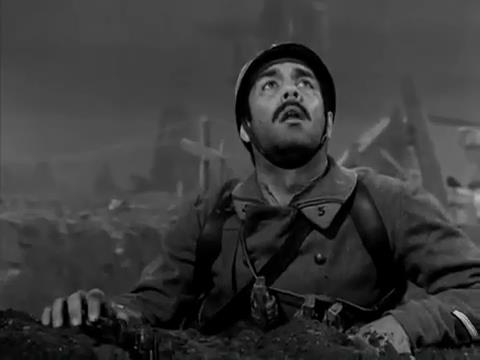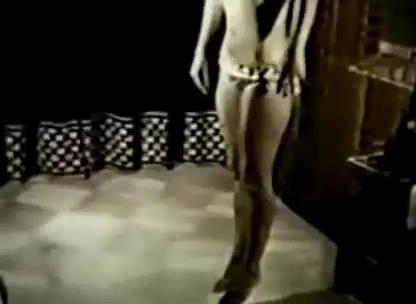The Dark Room
One Step Beyond
Some say photography isn’t an art, and still complain about their
driver’s license photos.
An American photographer goes to France for a spread called “The Face
of France”, her model is a ghost (Dalio) who killed his chienne of a
wife and tries to kill the photographer. Her negatives show no-one, but the
gravestone has a photographic portrait ensconced.
Leachman’s perfect characterization of the young hack isn’t
worldly-wise but self-possessed, “it’s what we call a mood piece,” says the
photographer to her model before fleeing into the darkroom (formerly cold
storage in an old maison) à la Broken Blossoms.
Newland’s camera movements fluidly tell the story.
The Vision
One Step Beyond

The vision of peace on the field of battle.
From Kubrick’s Paths of Glory to Wrede’s Private Potter, a thoroughgoing analysis. After the
court-martial, defense counsel (two weeks a captain, a lawyer in civil practice
before the war) inadvertently confronts his own shadow cast on a tapestry by
firelight, the film director’s art, “what else could it have been?”
“No letters, sergeant?”
“After eighteen years in the army? No, I have nobody to write to, Sir.”
The War to End All Wars.
The Clown
One Step Beyond
La Strada, one step beyond. A young and girlish wife, a
jealous husband, a circus clown.
They’re at a
café, the clown passes through, advertising the circus on small balloons. The
husband takes his scissors to snip off one of her tresses.
The circus is
just down the street. She runs weeping, Pippo tries to amuse her in his
trailer. She laughs and weeps again, he consoles her.
The husband
enters, grabs the scissors again and stabs her. Everywhere he goes, he sees the
clown behind him, reflected in a shop window or a rear-view mirror.
He crosses a
bridge in the park, suddenly he’s in the water, throttled by the clown, who has
been in his trailer all the time and is now led away by the police, sopping
wet.
Mickey Shaughnessy
is unrecognizable and perfect as Pippo, Yvette Mimieux fills the part
admirably, and Christopher Dark too is noteworthy as the unsettled husband.
Bad Actor
Alfred Hitchcock Presents
Your truly great
actor shows quite clearly that the other kind is just a face attached to a head
in an ice bucket.
Hitchcock runs an
acting school.
The Twelve Hour Caper
Alfred Hitchcock Presents
A theft of bonds,
foreseen in the morning, plotted over lunch, executed in late afternoon, gone
by evening.
A great picture
of office ennui (cf. René Clair’s Le Voyage imaginaire, for
example).
The dainty
dénouement is akin to “A Woman’s Help” (dir. Arthur Hiller).
Hitchcock with
machines that turn anyplace into Wall Street in a parade.
The Spy with My Face
Missile-launching
toys assault Illya Kuryakin, a miffed stewardess taunts Solo by embracing a
puffed-up clown named Bobo.
The deepest part
of the adventure saves the world, the faux Solo obtains the combination.
The THRUSH (Turdus)
observatory is Griffith Observatory with soldiers in the forecourt, a reference
to the Alpine murder observed through a telescope in Hitchcock’s Secret
Agent.
Newland calmly
takes all things in his stride.
A perfectly
visionary understanding in every detail, the sublimity of which is quite
remarkable.
The U.N.C.L.E.
base “108 kilometers east of Zurich” is reproduced in Herzog’s Cave of
Forgotten Dreams, “180 feet beneath the surface.”
“For being
naughty, you’ll have no dinner, and no more light bulbs.”
“The August
Affair”, an annual courier operation to Switzerland.
A commando raid
on THRUSH’s Australian headquarters “north of Melbourne” is monitored by THRUSH
agents to open the film.
Bored She Hung Herself
Hawaii Five-O

The
trick cyclist’s daughter and her hippie fakir boyfriend on a motorcycle.
A
curious equation.
The hard-working
script is by the co-screenwriter of Hang ‘em High (dir. Ted Post).
The rich
direction is a sine qua non.
My Lover, My Son
Destruction of an
English business magnate, murder by a German wife, the son not his heads for a
houseboat and a BBC vision mixer.
Roger Greenspun
advised his New York Times readers they would “wish you were somewhere
else doing something different.”
There Aren’t Any More MacBanes
Night Gallery
Mark
Twain’s idea of a backwoods Hamlet, something out of the interregnum
before Shaw. The prince of
Denmark is a philosophy major about to be disinherited by his uncle for
dabbling in witchcraft instead of finding “a decent, well-paid, respectable
job.” Hamlet tries a spell. “You missed,” says Rosencrantz (or Guildenstern),
an undergrad.
The melancholy
Dane, an American in this version, conjures up a beast of vengeance originally
summoned by a Salem ancestor, Jedediah MacBane. The rest is blood and guts,
Clemensesque as can be.
Joel Grey is the
fantastic fellow, Howard Duff his uncle. The thing must be seen to be admired,
and Newland’s direction plays it straight down the line, savoring it all the
way.
Dear Joan: We’re Going to Scare You to Death
The Sixth Sense
John Newland
behind the camera and Rod Serling in front for Night Gallery exactly
situate The Sixth Sense, except that the authors of the series are
Anthony Lawrence, a quintessential television dramatist, and Stan Shpetner,
producer of that masterpiece of terseness, The Rat Patrol.
Newland’s
balletic camerawork is perhaps not so much in evidence, the editing conveys
this, the succession of images is visionary and poetic by turns, and the
element of color is seen.
Joan Crawford
plays a woman haunted by her daughter’s death in a boating accident, she
accidentally intrudes on telepathic projections sent to frighten a deaf girl by
her set of friends, who exercise this power at séances for the thrill of it.
The vision is of a death by drowning.
The grieving
mother becomes their guest and is practiced upon with visions of her daughter
calling out in death, “why did you let me die?” The leader of the set fancies a
murder, the woman’s asthma has returned since the loss of her daughter, an
attack can be induced fatally, with no murder weapon.
The deaf girl
“oversees” this plan in a conversation filmed like the one in 2001: A Space
Odyssey. She warns the woman and makes off for help in a small boat. The
leader stops her, removes the outboard motor and punctures the hull with a
gaff. The girl can’t swim, drowning is her greatest fear.
Hiding from the
telepaths, observing the girl’s plight, the woman “sends” her a mental image of
the life jacket stored on the boat. Miraculously, this is received and
understood.
The leader is
fought by a sympathetic follower and overcome, the police arrest the lot.
The projection of
an image by Joan Crawford in a magnificent portrayal is matched by Kelly Jean
Peters’ great turn as she seizes the life jacket and puts it on, clutching it
to her bosom like salvation.
Crawford’s
makeup, costume and performance reflect Giulietta Masina in Juliet of the
Spirits, which is the evident basis of this striking analytical variant,
with its odd anticipatory refraction of Bergman’s Autumn Sonata.
In short, a
typically profound episode of The Sixth Sense, a series that combines
the psychism of One Step Beyond (professedly from true accounts made
intelligible by dramatic analysis) and the fine dramatic writing of The
Twilight Zone, with Lawrence’s revealed meanings and Shpetner’s reserve.
Through a Flame Darkly
The Sixth Sense
Visions of an old
schoolmate haunt a woman, the girl’s pointed glasses,
an antiseptic room, fire.
Even a road sign
is visible, she goes there.
A small town with
a helpful sheriff, no accidents reported, no business at the mortuary.
But there is the
room exactly as in the vision, down to the smallest detail, and the schoolmate
who collided with the mortuary attendant on the highway, unconscious and about
to be obliterated.
A fine bit of
sleuthing (Sandra Dee), a surprised sheriff (John Anderson), the rescued girl.
Candle, Candle Burning Bright
And Scream by the Light of the Moon, the Moon
The Sixth Sense
The vision of
fire comes to a girl home from college, who sees herself
melting in the flames as a wax figure, with sensations of burning and pain.
Dr. Rhodes visits
his student, she lives with a resentful grandmother who casts fortunes. An
admirer stuffs birds, an acquaintance is an artist. Someone, Dr. Rhodes
determines, is inducing these visions by means of a wax doll, an image sent to
her mind.
The admirer isn’t
loved, the grandmother is suspicious of the girl, who is about to turn 21 and
inherit the house. The artist is vengeful because his sweetheart died locked in
a cabin by the girl after a drunken party, a fire started inside, the cabin was
destroyed.
A thing of images
and doubts, the wyvern feet of the grandmother’s rocking-chair, the ruins of
the cabin, the artist’s wax figure losing its resemblance to the girl in the
flames.